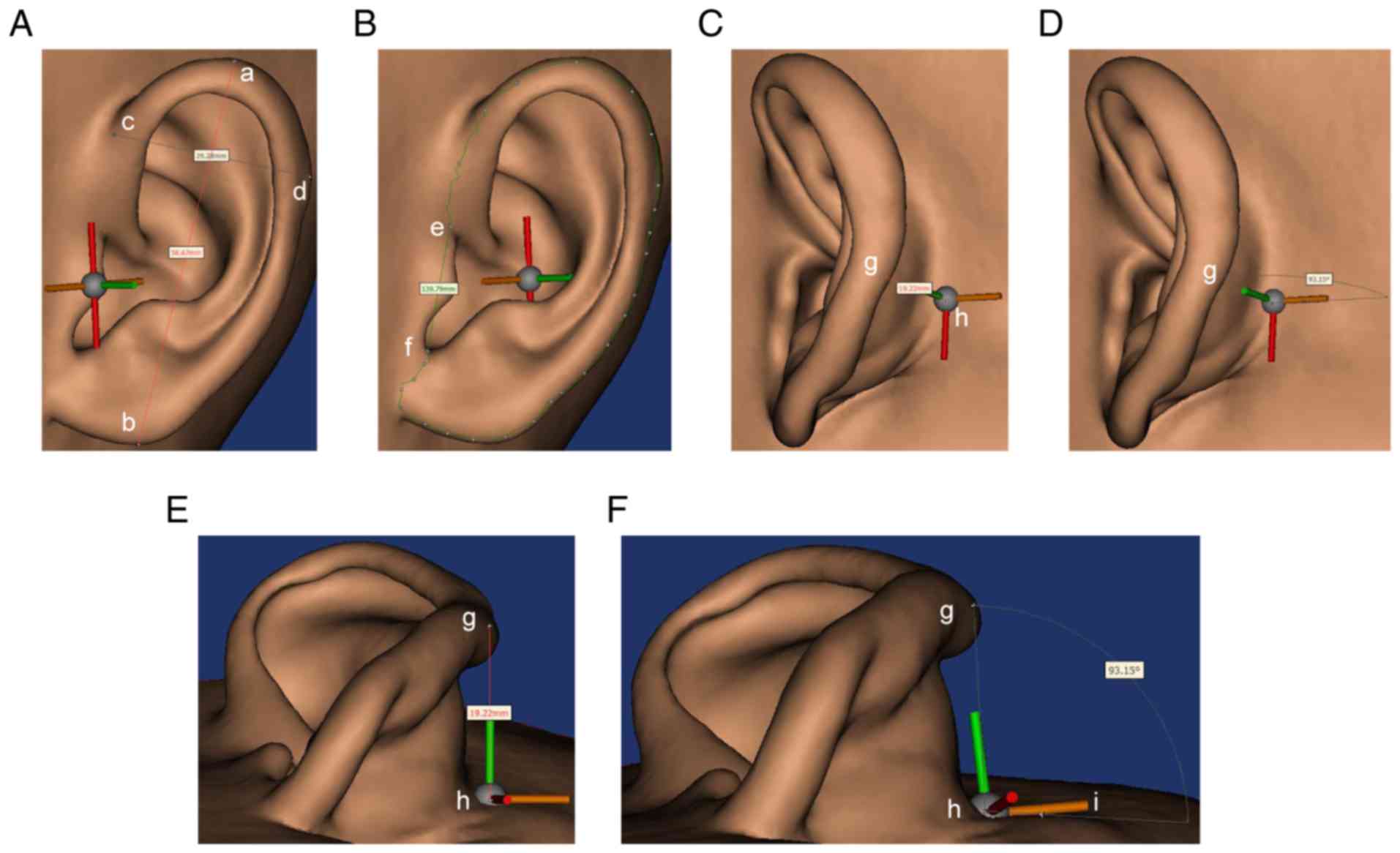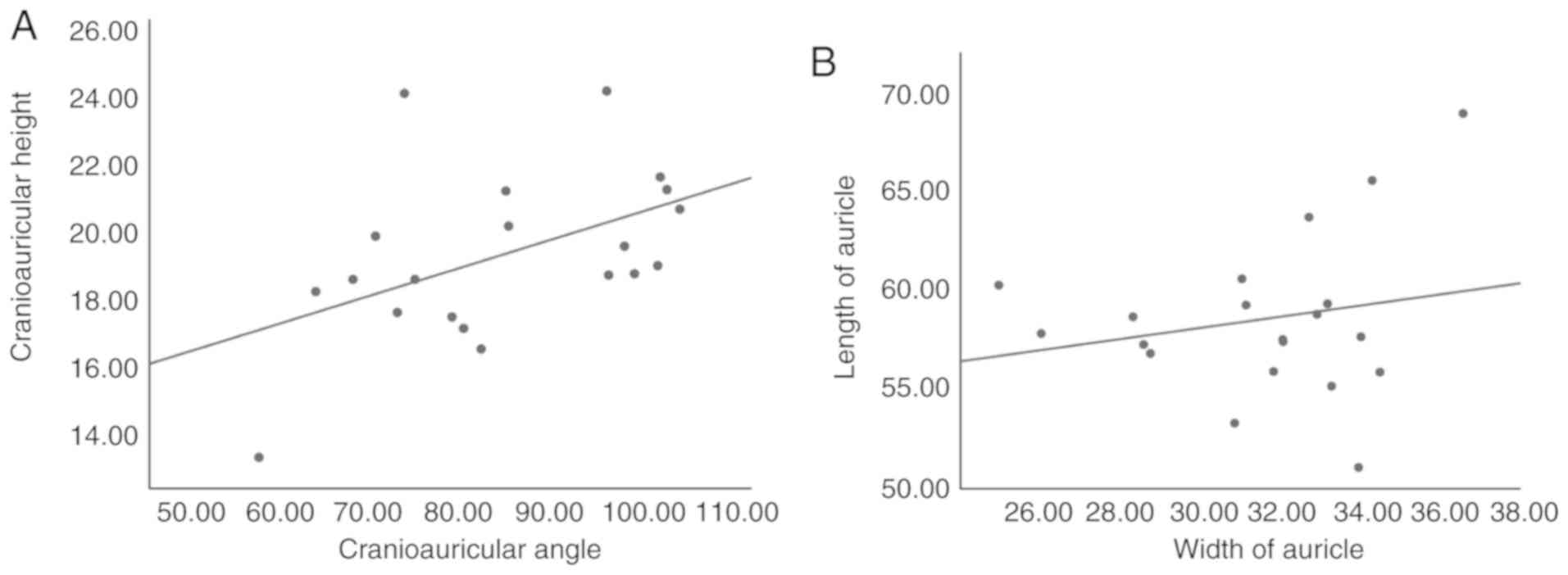|
1
|
Pawar SS, Koch CA and Murakami C:
Treatment of prominent ears and otoplasty: A contemporary review.
JAMA Facial Plast Surg. 17:449–454. 2015. View Article : Google Scholar : PubMed/NCBI
|
|
2
|
Mohammadi AA, Imani MT, Kardeh S, Karami
MM and Kherad M: Non-surgical management of congenital auricular
deformities. World J Plast Surg. 5:139–147. 2016.PubMed/NCBI
|
|
3
|
Akter F, Mennie JC, Stewart K and
Bulstrode N: Patient-reported outcome measures in microtia surgery.
J Plast Reconstr Aesthet Surg. 70:416–424. 2017. View Article : Google Scholar : PubMed/NCBI
|
|
4
|
Farkas LG: Anthropometry of the normal and
defective ear. Clin Plast Surg. 17:213–221. 1990.PubMed/NCBI
|
|
5
|
Zhao H, Lin G, Seong YH, Shi J, Xu J and
Huang W: Anthropometric research of congenital auricular
deformities for newborns. J Matern Fetal Neonatal Med.
32:1176–1183. 2019. View Article : Google Scholar : PubMed/NCBI
|
|
6
|
Leclère FM, Trelles M and Mordon SR:
Cartilage reshaping for protruding ears: A prospective long term
follow-up of 32 procedures. Lasers Surg Med. 43:875–880. 2011.
View Article : Google Scholar : PubMed/NCBI
|
|
7
|
da Silva Freitas R, Sanchez ME, Manzotti
MS, Baras F, Ono MC and de Oliveira e Cruz GA: Comparing
cephaloauricular and scaphaconchal angles in prominent ear patients
and control subjects. Aesthetic Plast Surg. 32:620–623. 2008.
View Article : Google Scholar : PubMed/NCBI
|
|
8
|
Kobayashi S and Maegawa J: Ear elevation
using 2-tiered costal cartilage on the same side as the
reconstructed framework. J Craniofac Surg. 22:1796–1799. 2011.
View Article : Google Scholar : PubMed/NCBI
|
|
9
|
Jiafeng L, Jiaming S and Xiaodan L:
Auricular reconstruction using a novel three-flap technique
improves the auriculocephalic angle. J Plast Reconstr Aesthet Surg.
69:1430–1435. 2016. View Article : Google Scholar : PubMed/NCBI
|
|
10
|
You W, Liu LJ, Chen HX, Xiong JY, Wang DM,
Huang JH, Ding JL and Wang DP: Application of 3D printing
technology on the treatment of complex proximal humeral fractures
(Neer3-part and 4-part) in old people. Orthop Traumatol Surg Res.
102:897–903. 2016. View Article : Google Scholar : PubMed/NCBI
|
|
11
|
Zhao X, Yu RT, Li JS, Xu K and Li X:
Clinical value of multi-slice 3-dimensional computed tomographic
angiography in the preoperative assessment of meningioma. Exp Ther
Med. 6:475–478. 2013. View Article : Google Scholar : PubMed/NCBI
|
|
12
|
Glittenberg C and Binder S: Using 3D
computer simulations to enhance ophthalmic training. Ophthalmic
Physiol Opt. 26:40–49. 2006. View Article : Google Scholar : PubMed/NCBI
|
|
13
|
Li L, Zeng L, Lin ZJ, Cazzell M and Liu H:
Tutorial on use of intraclass correlation coefficients for
assessing intertest reliability and its application in functional
near-infrared spectroscopy-based brain imaging. J Biomed Opt.
20:508012015. View Article : Google Scholar : PubMed/NCBI
|
|
14
|
Thorne CH and Wilkes G: Ear deformities,
otoplasty, and ear reconstruction. Plast Reconstr Surg.
129:e701–e716. 2012. View Article : Google Scholar
|
|
15
|
Lee BM, Kang SJ and Sun H: Simple
aesthetic correction for patients with acute auriculocephalic
angle. Arch Craniofac Surg. 16:24–28. 2015. View Article : Google Scholar : PubMed/NCBI
|
|
16
|
Jiang H, Pan B, Zhao Y, Lin L, Liu L and
Zhuang H: A 2-stage ear reconstruction for microtia. Arch Facial
Plast Surg. 13:162–166. 2011. View Article : Google Scholar : PubMed/NCBI
|
|
17
|
Shinohara H, Matsuo K, Hataya Y and Taki
K: Correlation between projection of the ear, the inferior crus,
and the antihelical body: Analysis based on computed tomography.
Scand J Plast Reconstr Surg Hand Surg. 41:288–292. 2007. View Article : Google Scholar : PubMed/NCBI
|
|
18
|
Johns AL, Lucash RE, Im DD and Lewin SL:
Pre and post-operative psychological functioning in younger and
older children with microtia. J Plast Reconstr Aesthet Surg.
68:492–497. 2015. View Article : Google Scholar : PubMed/NCBI
|
|
19
|
DellaCroce FJ, Green S and Aguilar EF III:
Framework growth after reconstruction for microtia: Is it real and
what are the implications? Plast Reconstr Surg. 108:1479–1486.
2001. View Article : Google Scholar : PubMed/NCBI
|
|
20
|
Zhou J, Pan B, Yang Q, Zhao Y, He L, Lin
L, Sun H, Song Y, Yu X, Sun Z and Jiang H: Three-dimensional
autologous cartilage framework fabrication assisted by new additive
manufactured ear-shaped templates for microtia reconstruction. J
Plast Reconstr Aesthet Surg. 69:1436–1444. 2016. View Article : Google Scholar : PubMed/NCBI
|
|
21
|
Khamaisy S, Zuiderbaan HA, Thein R, Nawabi
DH, Joskowicz L and Pearle AD: Coronal tibiofemoral subluxation: A
new measurement method. Knee. 21:1069–1071. 2014. View Article : Google Scholar : PubMed/NCBI
|
|
22
|
Huang JW, Shan XF, Lu XG and Cai ZG:
Preliminary clinic study on computer assisted mandibular
reconstruction: The positive role of surgical navigation technique.
Maxillofac Plast Reconstr Surg. 37:202015. View Article : Google Scholar : PubMed/NCBI
|
|
23
|
Asif MK, Nambiar P, Mani SA, Ibrahim NB,
Khan IM and Sukumaran P: Dental age estimation employing CBCT scans
enhanced with Mimics software: Comparison of two different
approaches using pulp/tooth volumetric analysis. J Forensic Leg
Med. 54:53–61. 2018. View Article : Google Scholar : PubMed/NCBI
|
|
24
|
Leifert MF, Leifert MM, Efstratiadis SS
and Cangialosi TJ: Comparison of space analysis evaluations with
digital models and plaster dental casts. Am J Orthod Dentofacial
Orthop. 136:16.e1–e4; discussion 16. 2009. View Article : Google Scholar
|
|
25
|
Bootvong K, Liu Z, McGrath C, Hägg U, Wong
RW, Bendeus M and Yeung S: Virtual model analysis as an alternative
approach to plaster model analysis: Reliability and validity. Eur J
Orthod. 32:589–595. 2010. View Article : Google Scholar : PubMed/NCBI
|
|
26
|
Santoro M, Galkin S, Teredesai M, Nicolay
OF and Cangialosi TJ: Comparison of measurements made on digital
and plaster models. Am J Orthod Dentofacial Orthop. 124:101–105.
2003. View Article : Google Scholar : PubMed/NCBI
|
|
27
|
Correia GD, Habib FA and Vogel CJ:
Tooth-size discrepancy: A comparison between manual and digital
methods. Dental Press J Orthod. 19:107–113. 2014. View Article : Google Scholar : PubMed/NCBI
|
|
28
|
Nawi N, Mohamed AM, Marizan Nor M and
Ashar NA: Correlation and agreement of a digital and conventional
method to measure arch parameters. J Orofac Orthop. 79:19–27. 2018.
View Article : Google Scholar : PubMed/NCBI
|
|
29
|
Wang D, Pan B, Lin L, Yang Q, He L, Song
Y, Zhou J and Jiang H: New methods for specialized subjective and
high-precision objective evaluation of constricted ears: A pilot
study. Medicine (Baltimore). 97:e129972018. View Article : Google Scholar : PubMed/NCBI
|
















